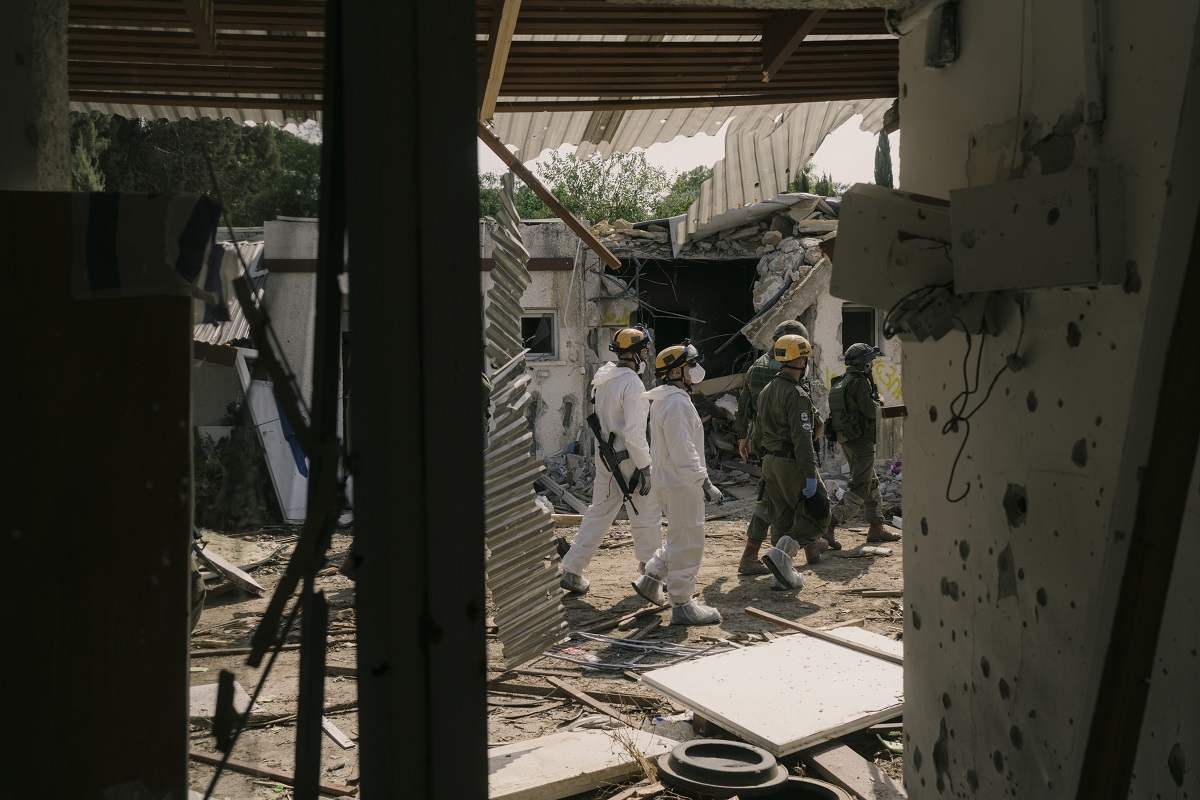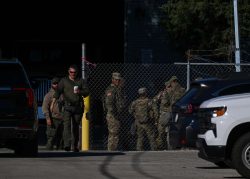
Israel Defense Force soldiers outside a house damaged in the Hamas attack, in the village of Kfar Azza, Israel, on Tuesday.
12:14 JST, October 17, 2023
TEL AVIV – On the morning of Oct. 7, hundreds of Hamas militants switched on their GoPros and cellphones and began live-streaming the deadliest attack in Israel’s history, massacring at least 1,400 people and abducting nearly 200, according to Israeli authorities.
What began as a highly organized stealth attack, using drone technology to overtake Israeli military observation points, soon devolved into a bloody and chaotic rampage. It underscored Hamas’s capacity for sophisticated planning and indiscriminate killing; the ability of the group to conceal details of a massive offensive operation and its struggle to manage fighters once they had bulldozed their way through Israel’s border fence.
It was, by both Palestinian and Israeli accounts, a staggering and unexpected Hamas victory and an indictment of Israel’s vaunted military and intelligence services.
Hamas’s political leadership in exile said it was shocked at the lack of resistance: “We were expecting to get a smaller number of hostages and return, but the army collapsed in front of us, what were we to do?” Ali Barakeh, a Beirut-based Hamas representative, said in an interview with The Washington Post on Monday.
“The Israeli army has become a paper tiger,” Barakeh continued, “and that’s why the number of hostages was so big, and the number of Israeli casualties was so big.”
Miri Eisin, a former senior intelligence officer in the Israel Defense Forces, said the operation was the result of at least two years of planning, a period that included two conflicts between the IDF and Palestinian Islamic Jihad, a smaller militant group in Gaza. At the time, Hamas was criticized for standing on the sidelines as PIJ leaders were eliminated by Israeli strikes.
It was part of a vast con, said Eisin, “to lull Israel into complacency,” while Hamas gathered intelligence and quietly built up its capabilities. The fighters’ apparent knowledge of Israeli border towns could have been gleaned in part from the thousands of Gazans who crossed the Israeli border on a daily basis, Eisin said, earning wages in the same communities that were overrun.
“Those who attacked Israel are not terrorist squads, but a commando brigade belonging to a large army, numbering in the tens of thousands, built over time with funds intended for humanitarian causes,” said Meir Ben Shabbat, a former Israeli national security adviser, adding that some of the militants carried “data files on the territories and settlements they raided.”
In a rare all-staff memo made public on Monday, Ronen Bar, the director of Israel’s Shin Bet intelligence agency, took responsibility for the failure to foresee the attack: “The responsibility is mine,” Bar wrote. “Despite a series of actions we carried out, unfortunately . . . we were unable to establish sufficient deterrence so as to thwart the attack.”
By posting footage of the assault on its Telegram page, Hamas magnified the psychological warfare against Israelis and glorified the killing rampage for its online audience of supporters.
“Time for photographs,” said one militant, pointing his phone at a body, blood running down the sidewalk. Another man in a flak jacket shot a rifle into the air.
The gunmen held hundreds of families hostage in their homes, forcing some to feed them, or to watch as they killed relatives, witnesses have said.
The militants burned corpses, beheaded a wounded man with a garden hoe and fatally shot drivers as they entered residential towns, according to hours of videos gathered by the Israeli military, some of which were shared with journalists on Monday. The images could not be independently verified by The Post.
The Israeli military is holding a number of gunmen from Gaza that it captured in the course of the attacks, officials said, and the captives have provided material and information that remains classified.
The militants had equipped themselves for a prolonged incursion, the IDF said Monday.
“They came with a lot of food, ammunition, medical aid,” said IDF spokesman Daniel Hagari. “They were not just planning to be there for a couple of hours.”
But the footage that has flooded social media also shows Hamas struggling in real time to deal with its horrifying success.
As the killing expanded to more than 20 Israeli towns and kibbutzim, one video shows militants trying to cram a large group of wounded hostages, two bodies deep, into the back of pickup truck. Militants who streamed in on motorcycles scrambled to find vehicles to carry their hostages back to Gaza. In Kfar Azza, militants went down the lines of parked cars, breaking windows and looking for one to steal. Yaffa Adar, an 85-year-old grandmother from the community of Nir Oz, was ferried over the border on a golf cart.
In 2011, Israel traded more than 1,000 Palestinian prisoners for a single Israeli soldier. Palestinian militants now hold 199 hostages, Israeli officials confirmed Monday.
“This was a unique mixture of state-of-the-art, disciplined planning, combined with . . . barbarism and brutality,” said Shimrit Meir, a former senior adviser in the previous Israeli government.
Barakeh, the Hamas representative, said the aim of attack was “to free Palestinian prisoners, stop Israeli aggression on al-Aqsa Mosque, and to break the siege on Gaza,” Instead, the assault has led to unprecedented Israeli airstrikes on Gaza, killing more than 2,700 people, and has rallied much of the world behind Israel as it prepares for a large-scale land invasion.
“We have prepared ourselves for the ground assault, we’re not afraid of it,” Barakeh said.
“Hamas thinks they carried out this operation, this thing that they called an attack for their freedom, and through their framing, they believe that they will win the coming war against Israel,” said Eisin, the former IDF intelligence officer. “But just as Hamas removed all red lines in targeting civilians, so too will Israel retaliate,” she said, predicting “a war for which we don’t yet have the words to describe.”
The Hamas attack was, above all, an opportunistic one, experts said, a response to Israeli and Palestinian political dysfunction.
Israeli Prime Minister Benjamin Netanyahu and his far-right government had spent months pushing through a plan to weaken his country’s judicial system, setting off nationwide protests, including among military reservists.
In the West Bank, the Palestinian Authority – Hamas’s longtime rival – was teetering on collapse, seen by many as complicit in Israeli raids that have made 2023 the deadliest year for Palestinians in the occupied territory in two decades. The authority, and its aging leader Mahmoud Abbas, stood to gain from a U.S. diplomatic push to normalize relations between Israel and Saudi Arabia, efforts that may have been permanently derailed by the attack.
Hamas sought to “make themselves relevant, and to this end, its tactics were atrocities,” said Anat Kurz, a senior fellow at Israel’s Institute for National Security Studies. As fighters temporarily seized hundreds of kilometers of Israeli territory, many Palestinians rejoiced.
“We finally realized that Israel can be broken,” said Ghassan Khatib, a former Palestinian politician in the West Bank. He believes Hamas would sweep Palestinian national elections if they were held tomorrow.
"News Services" POPULAR ARTICLE
-

American Playwright Jeremy O. Harris Arrested in Japan on Alleged Drug Smuggling
-

Japan’s Nikkei Stock Average as JGB Yields, Yen Rise on Rate-Hike Bets
-

Japan’s Nikkei Stock Average Licks Wounds after Selloff Sparked by BOJ Hike Bets (UPDATE 1)
-

Japan’s Nikkei Stock Average Buoyed by Stable Yen; SoftBank’s Slide Caps Gains (UPDATE 1)
-

Japanese Bond Yields Zoom, Stocks Slide as Rate Hike Looms
JN ACCESS RANKING
-

Tokyo Economic Security Forum to Hold Inaugural Meeting Amid Tense Global Environment
-

Keidanren Chairman Yoshinobu Tsutsui Visits Kashiwazaki-Kariwa Nuclear Power Plant; Inspects New Emergency Safety System
-

Imports of Rare Earths from China Facing Delays, May Be Caused by Deterioration of Japan-China Relations
-

University of Tokyo Professor Discusses Japanese Economic Security in Interview Ahead of Forum
-

Japan Pulls out of Vietnam Nuclear Project, Complicating Hanoi’s Power Plans
























